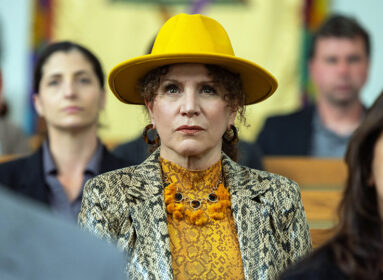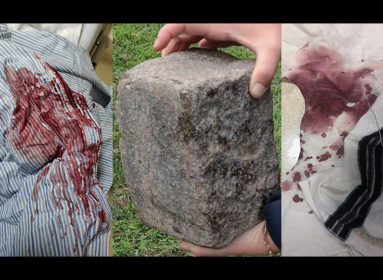Rwandan educators learn about the Holocaust at Hartford’s Greenberg Center
By Cindy Mindell
WEST HARTFORD – For a month this summer, the University of Hartford was home to 40 Rwandan teachers of English, who were sent by their government to refine their skills, as Rwanda moves to replace French as the country’s official second language.
The Rwandan Teacher Education Program was first conceived by the Maurice Greenberg Center for Judaic Studies and funded by a grant from Alan Lazowski, chairman and CEO of LAZ Parking, in honor of his parents, Rabbi Philip and Ruth Lazowski. From July 28 through Aug. 22, the educators worked with faculty from the university’s department of education, and completed their program with a week-long course on the Holocaust and genocide, designed and taught by Dr. Avinoam Patt, the Philip D. Feltman Professor of Modern Jewish History at the Greenberg Center.
The educators’ program is part of an initiative bridging the University of Hartford and the government of Rwanda, spearheaded and directed by Dr. Joseph Olzacki. Olzacki was brought to the university by the Greenberg Center as special advisor on genocide and Holocaust education. Since 2010, Olzacki has been developing a relationship with the government of Rwanda, working with the ministry of education and human-rights organizations on anti-genocide curricula.
Supervised by Patt, Olzacki organized a series of events for the center’s Genocide and Holocaust Education Initiative. For the March 2013 inaugural event, Rwandan president Paul Kagame came to campus to participate in an academic symposium on the aftermath of genocide and to deliver a public lecture. At the same time, Olzacki and the Greenberg Center began planning the month-long Rwandan Teacher Education Program for summer 2014.
Since Kagame’s visit, the focus of the Rwandan government has shifted from genocide education to a more basic and vital priority for the country now: training teachers of English. As a result, the Rwandan Teacher Education Program has expanded from a genocide education curriculum to include broader educational components – teaching English as a second language, education methodology and practice, education-leadership skills, and using the arts in education.
With this new scope, the program was shifted in July from the Greenberg Center to the university’s Office of the Provost, with Patt teaching a week-long course on the history and memorialization of genocide.
In his course, Patt discussed the concept of genocide and provided a basic understanding of the causes and consequences of genocide in the 20th century. Students examined the social and psychological underpinnings of human morality through a series of historical case studies spanning from the Holocaust to genocides in Armenia, Cambodia, Bosnia, Rwanda, and beyond.
Key among their considerations was the importance of memory and commemoration: Why do we remember genocide? What do we remember? And how do we remember? Patt began by introducing the concept of zachor – the Hebrew directive to remember – with a poster displayed in a post-World War Two DP camp, instructing: “Remember what Amalek did to you. Collect and Record!” After learning about Judaism and antisemitism, the educators discussed the Holocaust and other 20th-century genocides, and kwibuka, the Rwandan equivalent of zachor.
“Twenty years ago, their country suffered one of the worst genocides of the 20th century, when one million of their people were killed in three months,” Patt says. “I had to imagine that I was talking to Holocaust survivors 15 or 20 years after the Holocaust and around the time of the Eichmann trial saying, ‘This is how we should think about genocide.’ I didn’t want to tell them what they should teach about their genocide or what they should remember. Rather, we discussed why it’s important to remember, how we remember, and the different tools of memory we have at our disposal – and why we want to teach this.”
Rwandans commemorate the 1994 genocide every April, the month the killings began. “There is a very active memorial culture in the country; you can’t escape the history,” Patt says.
What sets kwibuka apart is the concept of unity and reconciliation: Rwanda has been rebuilding its society with killers and survivors living side by side – a much different scenario from that of the Holocaust, and a challenge to the Rwandan educators.
“One of the triggers of the genocide was the ethnic difference between the Hutu perpetrators and Tutsi victims,” Patt says. “While some want to call it the ‘genocide of the Tutsi,’ the government is trying to create a Rwandan national identity that transcends ethnic difference. So we discussed how educators teach about a genocide that is about ethnic difference while emphasizing national unity.”

Rabbi Philip Lazowski signs copies of his book following his talk with Rwandan students at the University of Hartford.
As part of the class, the educators met with Rabbi Philip and Ruth Lazowski of West Hartford. Rabbi Lazowski, a Holocaust survivor who has worked with Olzacki on Holocaust education initiatives, was asked by a student whether he would be able to forgive the Nazi who killed his family if he had the opportunity to meet him.
The question was significant, Patt says, because Rwandans are being asked to do just that: find a way to forgive their countrymen for murder. The rabbi’s response: forgive but don’t forget.
The Lazowskis’ visit was important in another way. “For the educators to meet them and hear them say that they’re among the last Holocaust survivors, the educators are looking into their future and thinking about what happens when, years from now, there are no survivors of the Rwandan genocide.”
The class learned about the various ways in which Jews have memorialized the Holocaust and discussed how to apply those approaches to their country’s tragedy. As with Holocaust education, the task before the Rwandan teachers is to impart memory to students who did not experience first-hand the event being commemorated. Not only that, Patt says, but they will have to teach the topic in English, removing it even further from the students’ experience.
For their final project, the educators designed lesson plans on memorializing, particularly of the Rwandan genocide. Ideas included having students meet with survivors and record their stories, or meet with a rescuer and the person s/he rescued. Students could also learn about the different memorials to victims of the genocide and take on the maintenance of one of them as a social-action project.
“These are all opportunities that exist in Rwanda because the genocide is so recent,” Patt says. “You have people alive who could talk about the imperative to do acts of goodness and kindness and the impact it could have.”
For Patt, the experience of living in the wake of genocide was the most striking aspect of what he learned from the Rwandans: the tragedy and the memory of the tragedy are ever-present. But at the same time, in order to build a new society and a strong nation, they must transcend the suffering and achieve reconciliation between perpetrators and victims.
No two cases of genocide are the same, Patt says. After the Holocaust, the vast majority of Jewish survivors did not remain in Germany or Poland, where the genocide occurred. Often, a new ethnic map is redrawn after genocide, like in the former Yugoslavia, where coexistence seems to be impossible. In Cambodia, an elite that tried to impose ideological hatred was defeated and rooted out of society. Rwanda is unique.
Patt hopes that the educators return to Rwanda with the tools to keep memory alive in the generations of children they will touch. Both despite and because of the arc of Jewish history, Patt sees a fundamental strength at the heart of Judaism, which he used to inform his week with the Rwandan educators.
“It’s a mitzvah to help people remember,” Patt says. “If that’s something that we Jews have unfortunately developed an expertise with, we should help others do so as well.”
Comments? email cindym@jewishledger.com.








 Southern New England Jewish Ledger
Southern New England Jewish Ledger










